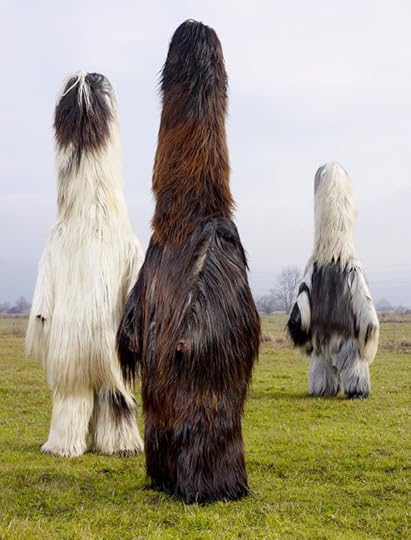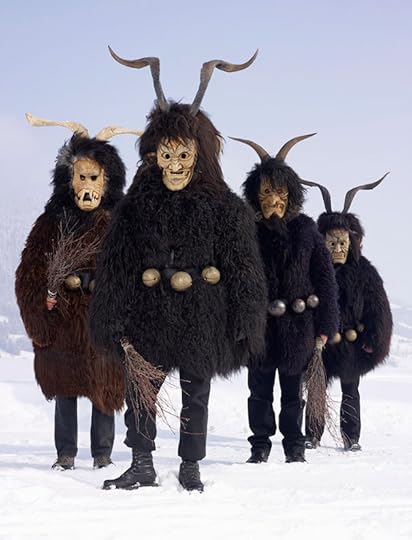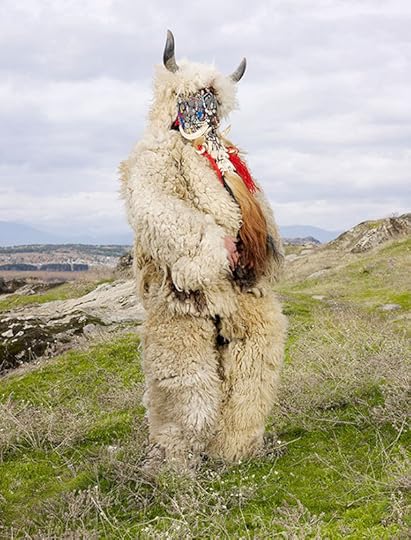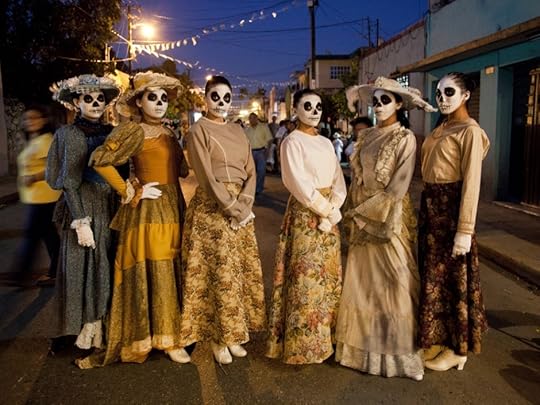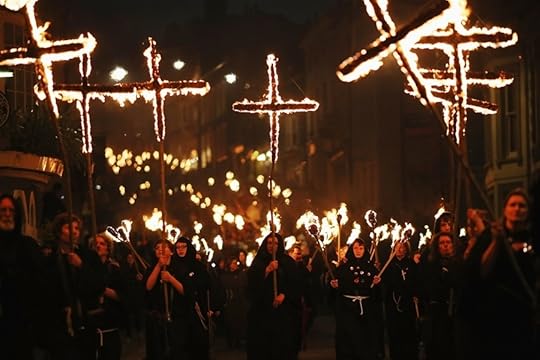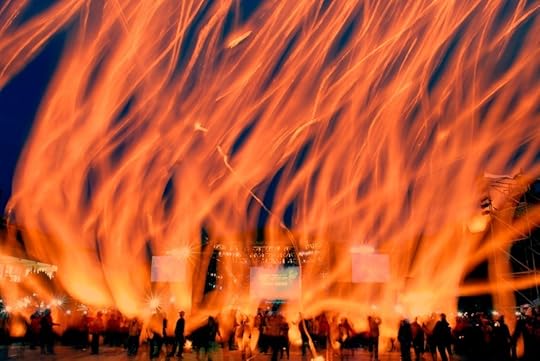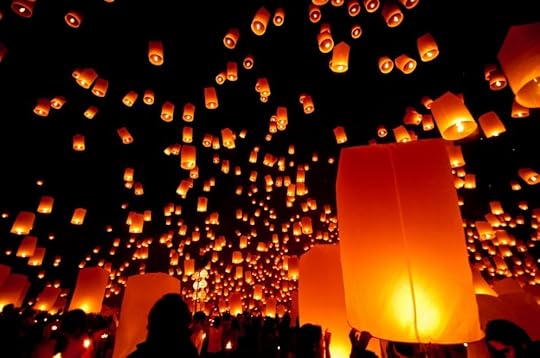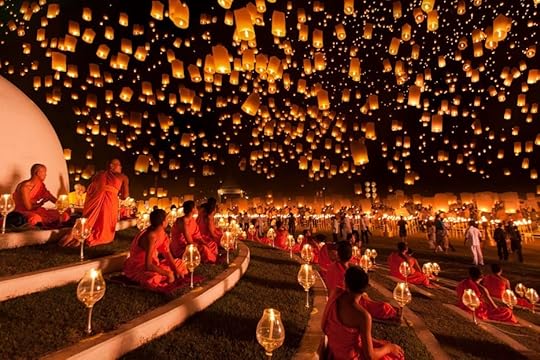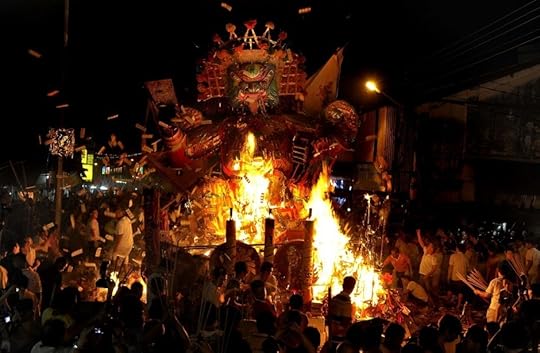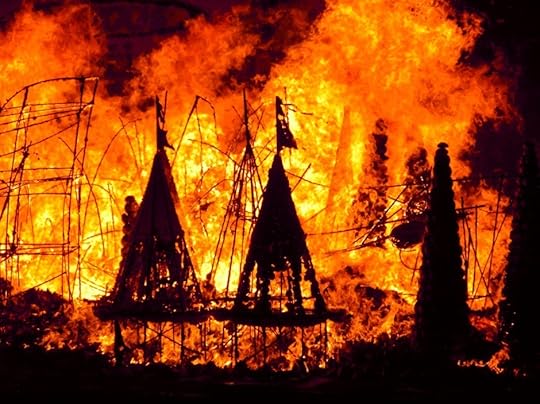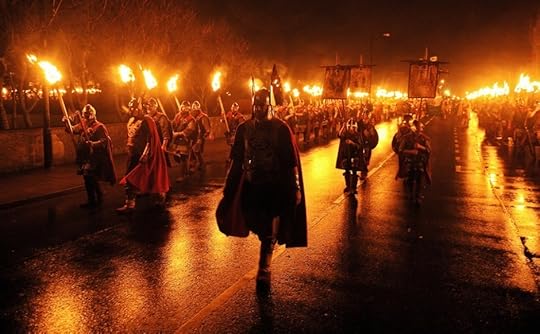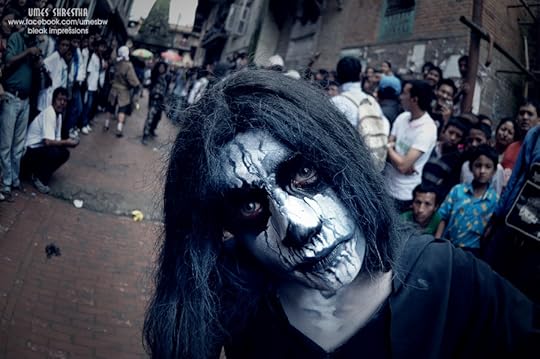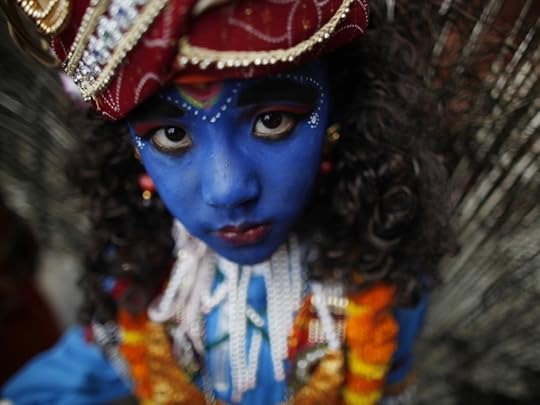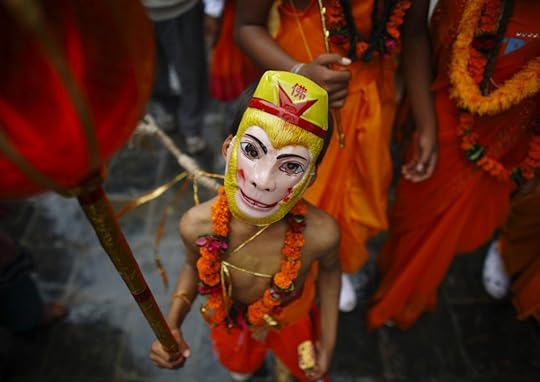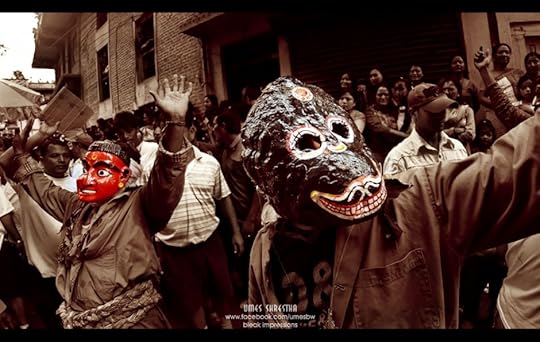Matador Network's Blog, page 2190
October 26, 2014
World's creepiest holidays [PICs]
Halloween’s become tremendously popular in the US as a scary dress-up holiday, but it started as All Hallows’ Eve, a Christian holiday dedicated to honoring the saints, martyrs, and the dead. While the holiday is a Christian one, its origins are in Gaelic pagan harvest rituals. (via, via, via)
Wilder Mann
Wilder Mann isn’t a specific holiday but rather a collection of photos by French photographer Charles Fréger of costumes worn in a number of tribal European pagan rituals. One of the ubiquitous characters in these rituals is the wild man (“Wilder Mann” in German) who’s half man, half animal. It goes to show that even though much of Europe has globalized, there are still pockets of ancient paganism being practiced on the continent. (via, via, via, via)
Day of the Dead
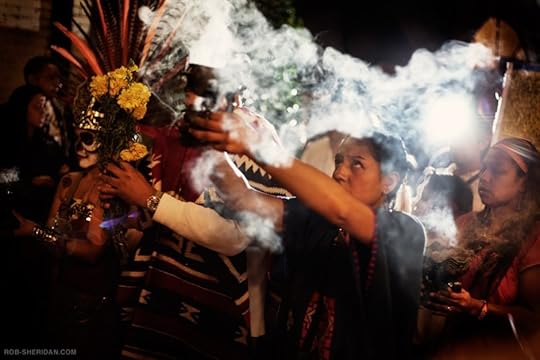
Mexico’s Dia de los Muertos falls at the same time as Halloween and, like Halloween, is actually a fusion of the Christian All Hallows’ Eve and All Saints’ Day with indigenous religious traditions. Dia de los Muertos began as an Aztec holiday in honor of the goddess Mictecacihuatl and blended with Christian traditions during the European colonization of the country. The holiday is probably best known outside of Mexico for its colorful and spectacularly spooky aesthetic. (via, via, via)
Bonfire Night or Guy Fawkes Night
“Remember, remember, the fifth of November, the gunpowder, treason, and plot,” the rhyme goes in England. It commemorates the attempt and failure of a group of Catholic radicals to blow up the English Houses of Parliament. A holiday sprang up around the ritual burning of effigies of Guy Fawkes, the most memorable member of the group. In the past it had distinct anti-Catholic undertones, and sometimes effigies of the pope were burned instead of Fawkes, but now it’s usually celebrated with a gigantic bonfire and a fireworks display. (via, via, via)
Lantern Festival
Lantern festivals occur all across Asia and have different backgrounds, but in China they’re believed to have started as a ritual to acknowledge the end of winter and the return of light. Other lantern festivals occur at the autumnal equinox, more in line with the custom of Halloween. It’s easily one of the world’s most eerily beautiful festivals as the celebrants release thousands of floating lanterns into the night sky, sometimes to symbolize letting go of the old self and welcoming a new one. The top photo is of a lantern festival in Taiwan, while the bottom two are in Thailand. (via, via, via)
Hungry Ghost Festival
The terrifyingly named Hungry Ghost Festival is a Buddhist observance commemorating the dead. The holiday is closely tied with ancestor worship. In order to honor their deceased living relatives, many Buddhists will leave open seats at the festivals for the dead, often with plates of food. The holiday occurs across the Buddhist world and thus has many variations, but it may involve lanterns, performances, and bonfires. (via, via, via, via)
Up Helly Aa Fire Festival
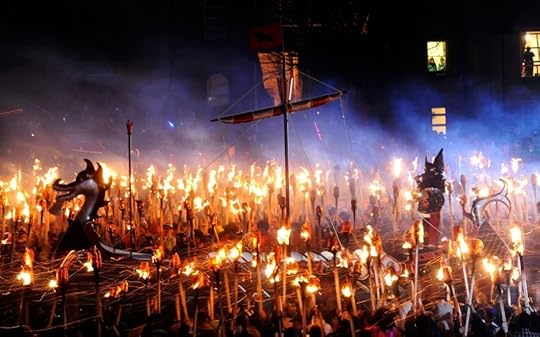
Up Helly Aa is a spectacularly picturesque festival in Scotland’s Shetland Islands. It’s celebrated at the end of the Christmas season and has Viking influences. The largest festival takes place in Lerwick and consists of a torch procession that ends with the tossing of the torches into a Viking longship, which is allowed to burn. (via, via, via)
Gai Jatra
Gai Jatra, the festival of the cows, is a Nepalese celebration commemorating the people who died in the previous year. The cows are brought to the festival by anyone who’s had a family member die that year. Sometimes the cow will be substituted with a small boy dressed as a cow. While there are certainly creepy or ghoulish elements of the festival, for the most part it’s a much more lighthearted affair than most other festivals of the dead. It’s believed to have started when a Hindu king’s son died, and the king, wanting to see his queen smile again, threw a festival that would reward anyone who could make her laugh. The festival is now marked by jokes, satire, and mockery. (via, via, via, via)
Famadihana
Famadihana wins as the world’s most hardcore festival of the dead. It’s a ritual performed by Madagascar’s Malagasy people, and it’s known as “the turning of the bones.” In it, the relatives literally dig up the dead, rewrap the corpses, and then dance with the shrouded bodies. The tradition comes from the belief that the dead can’t fully enter the afterlife until they’re wholly decomposed, so it can take many years for the process to complete. (via, via 

October 25, 2014
Celebrity travel profile: Alexa Vega

Photo via PMK/BNC
Alexa Vega can currently be seen in the film 23 Blast in theaters now, as well as the hit television series Nashville.
1. Name your favorite travel destinations. What makes them so special?
AV: My husband and I love to escape to Maui, we camp all over the island. We also love warm weather of Miami, and we have a bunch of family all over Florida. Florence, Italy was so beautiful. I’ve had to go there for work, where I literally flew into Florence for the day, but the city still took my breath away. It’s so romantic! My husband and I are obsessed with cruises as well. We are constantly taking cruises to new loctations. Our preference is in the Caribbean. It is so warm and beautiful, with such a tropical feel. I am a junkie for the sun! Some of my favorites cruise stops are the Bahamas, St. Martin and St. Thomas!.
2. What’s one thing you always pack? Something you always forget to pack?
AV: My hair stuff! I have crazy curly hair, and if I don’t pack the proper tools to contain it, I’ll look like a crazy lady the whole vacation. I always forget to pack my mini steamer, and I always need it!
3. What’s it like to travel in the film industry? Do you ever get time to explore on your own?
AV: I love traveling for films. So often we go to cities we would never visit on our own. I just wrapped a film that shot in Manistee, Michigan. I never would have explored that town had I not been shooting. It is so small! But I love being able to say I have been there. I find it hard to explore a whole lot, it always depends on the production schedule. You can explore some cities more than others. It’s the luck of the draw.
4. Where is a city, country, or place you’re dying to visit?
AV: South Africa! I really want to experience a safari. My husband and I love the outdoors, and are inspired by the Discovery Channel. It would suit us well.
5. Do you prefer traveling solo, with a friend/family member, or with a large group of people? Why?
AV: I love traveling with a large group of people. I think there is always something to do regardless of weather and time. Plus, sharing those moments with people closest to you gives you the best memories. Although, my husband and I still haven’t had our honeymoon yet because we keep inviting people on trips with us. So we have to reserve one trip just for us soon!

Travelers are old souls [photos]
Travel is often depicted as an activity for the young of body, but rarely for the young of spirit. It takes the courage of an old soul to leave the familiar and examine the cultural assumptions that are the foundations of our lives. It is the travelers who refuse to accept “because that’s the way it is” as an explanation of why we live as we do.
With that in mind, we approached members of MatadorU and asked them to illustrate a moment in their travels where they felt like old souls, or a moment when they realized travel had irrevocably aged their souls. See their answers below. 

1
Maria Lopes
"In Shanghai I spent an afternoon photographing kids. I spotted this little fellow eating noodles outdoors happily ever after, laughing with his mom. I recalled laughs with my own mom, and how I missed her smile. I gazed the camera onto to the kid and said in English "Keep on smiling in the free world kid.” He didn't understand, but rewarded me with this contagious grin. His mom was dazzled with the picture, and thanked me by kissing me on my cheek. They continued enjoying the noodles and the afternoon with each other. I wished I could have gone back in a time machine and enjoyed some laughs and butter spaghetti with my mom. Amazing how unpredictably homesickness catches you sometimes."
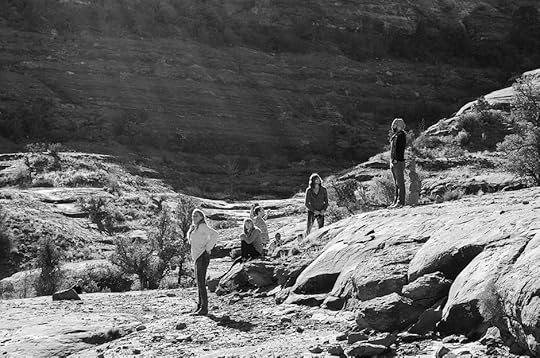
2
Nat Kuleba
"Exploring ourselves and this planet earth as an adventurous playground, and to share this amongst each other, is the greatest joy. We are all made of the stars."
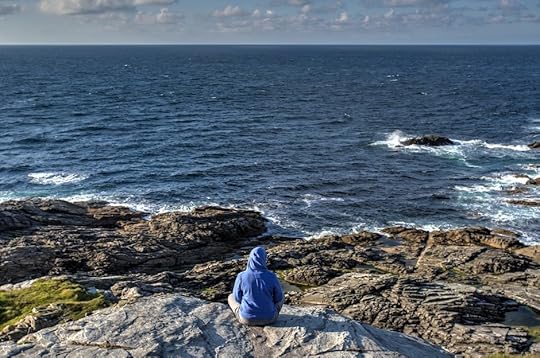
3
Alisa Kennedy
"On a road trip through County Donegal this summer, my friend and I enjoyed a blissful moment on Malin Head, the northernmost point in Ireland. Sitting on a cliff and gazing over the north Atlantic, we watched as the waves crashed and the sun disappeared below the horizon. We were at the edge of the world."
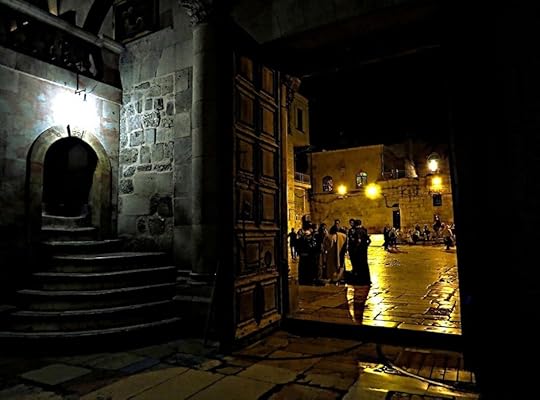
4
Barbara Litzlfellner
"It is already dark and I am walking the winding streets of Jerusalem for the first time. The air is vibrating with told and untold stories that every single stone in these walls yearns to share. I breathe them in until my lungs almost burst. I ignore the bulk of tourists and just keep walking. I smile to myself and shut out all that doesn’t fit. In the middle of one of the most visited parts of Jerusalem’s old town, I find serenity. "
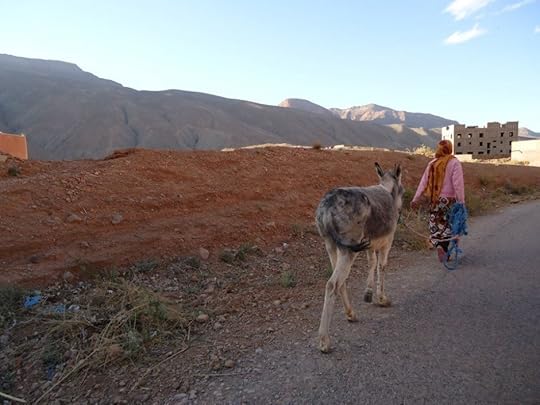
5
Bianca Sartori Quadros
"Watching the locals through the window during a road trip to Merzouga, Morocco made me think about values and how traveling gives us the privilege to look at life through different perspectives."

6
Marjolein van Paridon
"I made a mad dash for the docks to find Mo, my boatman to the resort, missing. Jovan calmly asked if this was my first time in Belize. 'You see miss, here we have this thing called island time.' He convinced me to grab a drink at the bar and wait for Mo to return. As dark rum slowly unfurled the tightly coiled spring that was designed to keep my inner clock ticking, the frantic pace of business school, work, and life in London ebbed away. I re-calibrated my timepiece and embraced what I was here for—friends and family. The things we should be wasting time on."
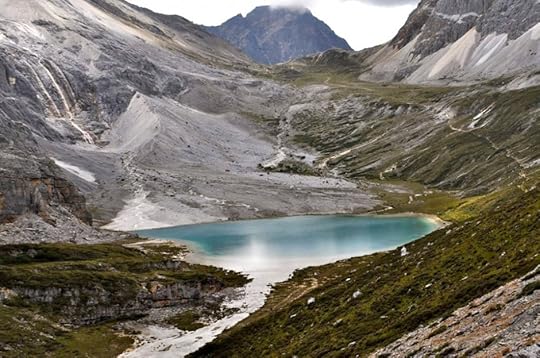
7
Neroli Li
"A Tibetan pilgrim walking a few meters behind cried out; after seven-hours trekking, the sacred lake had finally come into sight. He ran to its edge with and excitement, bending at the knees in a pose of worship when he reached the blue water. A week earlier, I had survived a severe car crash and the situation had affected my perception of 'realness' in the things around me. The mysterious and pure blue of the lake inspired humbleness and awe. The Tibetan man’s response reminded me just how insignificant life can feel in the face of nature. "
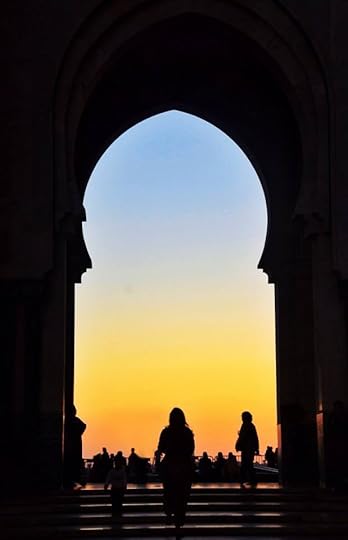
8
Carla Martinez
"The thing is, I’m not genetically made for offices. They go against my nature. This sounds like a total paradox, given that I’m a lawyer. The thing is, just as it basically happens to everyone at some point, I went through a life crisis. You know, 'I don’t know who I am, where I’m going...' One fine day, and because life took me that way, I packed my bags and left to travel through Europe and Morocco. I found that I have a nomadic soul, that my spirit thrived every time I saw or experienced something new. So, I was with a newly made friend walking through Casablanca at sunset. I almost randomly took a photo that illustrated exactly what I felt; everywhere you go, becomes irrevocably a part of you to some degree. You become the colors, the shadows, the feelings…"
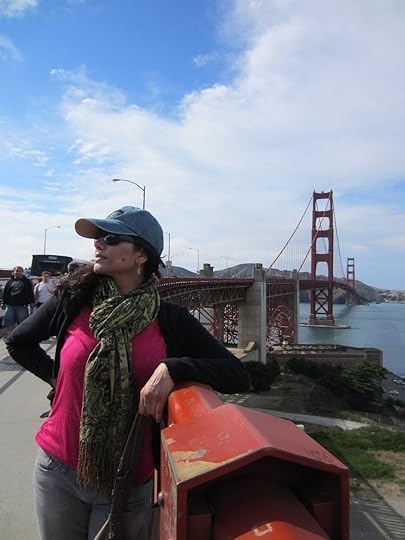
9
Alana Simpson
"Sam was such an inspiration. No matter what came her way, she chased her dreams with vigor and passion while still making time to be a mother and a friend. I had never been to the Golden Gate Bridge before, and I felt honored to share that special moment with her. It was an amazing day. We laughed and shared stories while playing by the sea. The most important skill we learned was how to hold a sting ray, and the most important lesson we learned that day was how touching it can open your heart to a stranger."
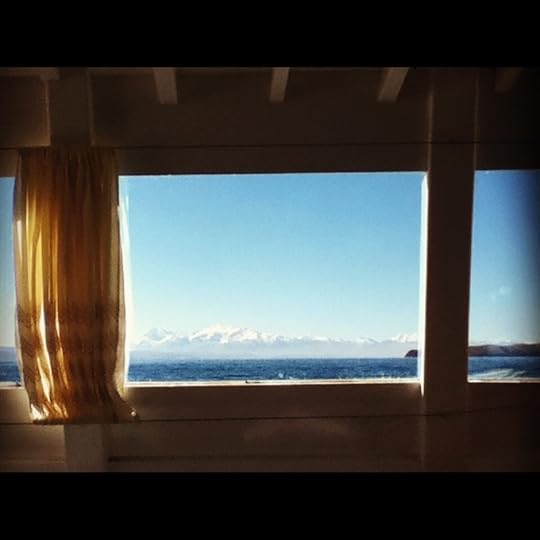
10
Samantha Jenkins
"I took this image in Bolivia when I was 21-years old. I had spent the previous week zip lining in the Sacred Valley and was about to have one of the most culturally fascinating and hedonistic weeks of my life in La Paz. However it was a seemingly insignificant glimpse that has resonated with me."

October 24, 2014
12 things to do before having kids
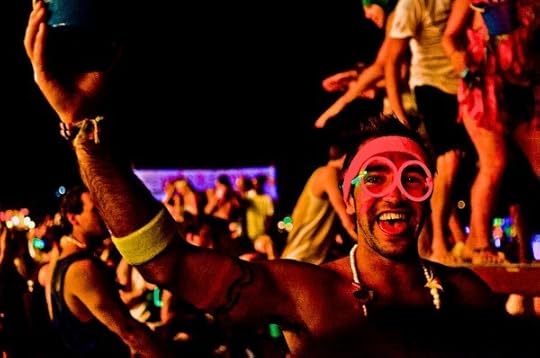
Photo: Joe Stump
I love getting old. I’m 28, and I much prefer it to being 22. I found a few gray hairs earlier this year; I’ve finally grown a decent beard; and I’m getting carded less and less at bars. I actually enjoy adult things like having money, too. I spend it on “investments” (i.e., a basic savings account) and fancy Scotch whiskies. If I pass an abandoned pizza box, I’m not as tempted as I used to be to just take a chance on it for the free calories. I don’t even eat ramen from styrofoam cups anymore. Welcome, adulthood. I’ve been expecting you.
But earlier this year, I started to feel my first twinges of panic about my fading youth. Earlier this year is when I got engaged to my longtime girlfriend. It’s when we started talking about having a family and buying a house. It’s when we started talking about settling down.
So my fiancee and I are trying to cram all of the irresponsibility we can into the time between now and whenever we inevitably decide to buy a house and have kids. This is our last chance. Take heed, young’uns. These are the things you’ll regret not doing when you suddenly realize you can’t do them anymore.
1. “Paratroop” into a city
Paratrooping is when you go to a city with no place to stay. Usually, it’s because you plan on finding someone to sleep with at the bar, and you plan on using their bed after the festivities, although it’s far more likely you’ll end up on a bench.
2. Try chemicals at random
You just can’t have kids at home and take a hit of the unnamed substance being proffered to you by the Keith Richards lookalike at the music festival. Worst-case scenario without kids is you go insane or die. Worst-case scenario with kids is you go insane or die and your kids starve to death. The choice is clear. Toke it now.
3. Go on a BASE jumping / shark-diving / parachuting / lion-smacking excursion
It’s in a similar vein to the drugs, and the theme is this: When no one else depends on you, it’s sad if you die. But it doesn’t matter if you die.

More like this 20 things travelers do in their 20s
4. Run with the bulls
You’re not Ernest Hemingway, you can’t spend the rest of your life facing down charging animals. Also, you can’t be drinking sangria at 7am when the kids want to go on a hike later in the day.
5. Live for days on street food alone
Plenty of people who are better than you have gotten tapeworm. Your kid shouldn’t be one of them.
6. Skip a return flight
There’s way more romance to staying and “just living” for a while when the word “foreclosure” never enters the picture.
7. Go to a city and ignore its museums
Yeah, there’s a ton of great art in the Louvre — art your future kids would benefit from seeing — but there’s a ton of wine outside the Louvre. Wine your current self would benefit from imbibing.
8. Don’t buy bottled water or iodine tablets
“Meh,” you can tell yourself, “if I just go ahead and accept that I’m gonna have diarrhea now, I’ll build up a resistance to it for later.” You can totally do this to your kids on your family trip if you want to build up their tolerance to bacteria and viruses, but you should expect them to justifiably hate you forever for it.
9. Go to remote places
A 20-day hike through the Amazon is awesome at any age, but is the worst if you’ve got a kid asking “Are we there yet?” or “Can you just carry me?” the entire time.

More like this 6 reasons millenials make the best travelers
10. Go to dangerous cities
Just because a place is dangerous doesn’t mean it’s not awesome. But the awesomeness will be lost on kids.
11. Go anywhere that isn’t kid-oriented
My dad used to take us on long road trips through Yellowstone. We were too busy bickering in the back seat to enjoy it. We ate Disney World right up, but the world’s most beautiful national park? Nah.
12. Underpack
“I’ll just find what I need when I get there,” doesn’t work in a world where wet wipes are an integral part of your day. 

Story behind the shot: Fang-Od
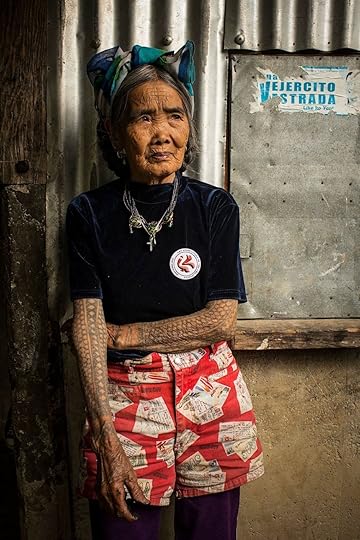
Photo by the author.
It was a long trip from Manila to Kalinga: 12 hours by bus, three hours by jeepney, another hour by minivan, and finally, three hours of trekking into the jungle. Finally, we approached a small house. Outside the door was a plywood sign, “Welcome. Tattoo Artist Fang-Od,” written in red paint. She was tattooing someone at that very moment.
Seeing her work, slowly and methodically with a stick tipped with an orange thorn, and a pot of ink, I was completely starstruck. Fang-Od was old, the wrinkles of a long life carved into her face, and yet she sat with poise, completely focused on her work. She was covered in methodical patterns from neck to toe, her own tattoos emerging and disappearing along every limb, in and out from around her clothing. The entire wall was covered in photos of her alongside those who had trekked to receive her work, and there was a line of fresh backpackers, all tired from the trek in, slumped against the wall, waiting for their turn.
To capture a portrait of Fang-Od, I had to bide my time. I waited for her to wrap up for the day. Before she left, I asked her niece to ask Fang-Od on my behalf because I don’t speak the village dialect, and Fang-Od doesn’t speak English or Tagalog.
Fang-Od smiled gently at me, nodded, and removed her jacket. I used the light coming through the door to light her, and I chose vertical to allow for more of her mesmerizing tattoos to show. Sadly, for me, all the other travellers jumped up and also started taking a photos, so I lost the connection I had with her. However, I did get this one frame, this one moment, which I love because it highlights her strength, and her commitment to an ancient tradition. 

Most inspiring NYC timelapse ever
Follow Matador on Vimeo
Follow Matador on YouTube
About a year ago I was invited by the creators of www.hugeapp.com to make a video that shows New York City in a creative way — as one of the most-photographed and documented cities in the world this was no easy task!
So I bought a ticket and started wondering what I should to do to make my edit stand out. I really didn’t want to make another NYC timelapse of traffic and sunsets. I wanted to use a subject in the edit to act like a guide showing off the best spots in Manhattan. So, I called my friend Roza — she’s a Polish painter who was staying in New York at that time — and she became my model for a few days.
We spent a week shooting. The first two days were spent doing some research and looking for the most inspiring locations in the city. The next five days we spent shooting and used #NYC Hashtag as a kind of glue that pulled together almost 100 scenes.
I made the edit using HDR technique which means that for every frame I had to get three pictures – each one with different exposure. This creates a nice effect in post production after I put all of them together. It meant that for every second of video instead of standard 25 I needed 75 pictures.
I worked on this edit for another month and at the end of October 2013 it was ready, we are excited with the final result and hope you enjoy! 

Girls' guide to the stripclub
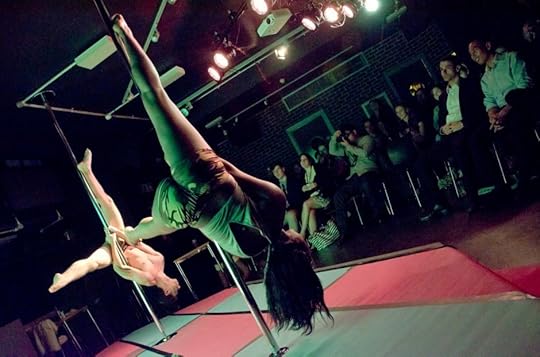
Photo: uclu photosoc
I’m something of an accidental strip-club frequenter. I’ve patronized clubs from Vegas’s Spearmint Rhino to a Detroit 8-Mile staple called the Coliseum to the tin-roof patchwork, double-wide glory of the Beehive in Western PA. I’ve seen a myriad of dancers and calibers from bottle service and burlesque to misspelled pubic tattoos and bullet holes in the bathroom.
When I was a teenager the only place that would serve my hell-bent underage self was the club where my friends worked as dancers. Being thirsty and bored I spent a lot of my misguided youth at The Stable. Before topless joints became my premier YA hangout I’d never really seen a naked chick, save for the bush-heavy group showers at Christian camp when I was nine. Blame it on the whiskey, but I learned to feel really comfortable in a strip-club environment. Being a girl myself and having friends in the industry granted me ingress to the workings of a club and the grievances of the dancers.
Whether there of their own accord or at the request of a male companion, girls spectating in strip clubs are a trend. Wherever you fall in the female demographic — initiated, disdainful, or inquiring — here are a few points of reference for the American strip club.
Preliminary Questions
Who should go to a strip club?
The experience isn’t for everyone, and unless you can walk in with deep pockets and an open mind it’s probably best to stay at home. If you’re curious, confident, and have an appreciation for the female form and the fine art of the twerk, go. Alternatively, you might hold a feminist stance on the dangerous correlation between gentlemen’s clubs and the objectification and commodification of women. Duly noted and respected; you’re entitled to your opinions, but it’s best to keep yourself and your discourse out of the club. No one likes a vegan at a pig roast.
Why would I want to go to a strip club?
You want to see a show, you like hot naked girls, or maybe Grey’s Anatomy is a rerun this week. On a purely gymnastic level stripping can be extraordinary. I’ve seen performances in a club that rival anything Cirque du Soleil has spat out. Take Savanna from the Stable, mom of three and a dead ringer for early-’90s-era Stephanie Seymour. I once watched her ascend a pole upside down using the sheer force of her leg muscles only to invert and land in a split to the bass drop of Tommy Lee’s oft overlooked opus “Get Naked.” She’s the sole reason I took up pilates classes. Or the chick in Key West, naked save for a gigantic Chinese dragonhead on her shoulders, who spun fire poi to the grievous beat of “Hells Bells.” One in four dancers is a college graduate, and Theatre and Studio Art degrees are expensive, copious, and rank low in career utilization, so it’s fitting that your local Suicide Girl can throw down something bordering on performance art.
Should I go to a strip club with my partner?
Patronizing a strip club with your partner can be exciting for both parties and add intensity and intrigue to your sex life. But it can also be a colossal failure. If you’re going with your boyfriend/girlfriend/husband/wife, have a conversation beforehand about expectations and conduct. He/she is going to receive flagrant female attention, but so are you. Every time I’ve visited a gentlemen’s club with a boyfriend (who may or may not have been a gentleman) the dancers always approached me first, complimented me, and gave the courtesy of asking if it was ok to dance for/on him. If you’re prone to insecurity or jealousy or opposed on principle to dancing naked women, stand up for yourself and tell your partner to devise another way to keep it interesting. Like a gimp mask or furry costume perhaps.
If you go to the strip club in spite of your own convictions to please your partner it will not end well. You’ll be angry, sitting with crossed arms while he’s confused, smiling weakly as you throw death glares at the nice girl in a fishnet onesie just trying to make her car payment. Sidebar, her car is most certainly nicer than either of yours. Said dancer will feel uncomfortable and likely pissed that you and your domestic are taking up prime paying real estate. No one has a good time.
Practical Information
Common strip-club misconceptions
No one wants to sleep with your boyfriend. It’s a stripper’s financial prerogative to feign interest. To her the most attractive thing about your partner is their wallet. If you’re concerned about your significant other cheating, he’s likely a slimy bro to begin with, or you’re insecure. Either fact has little to do with a strip club. The girls are there to hustle and get paid not homewreck. On the other side of the spectrum, the stripper in question doesn’t want to sleep with you either. She’s not there to manifest your bi-curious fantasy or the drunken promise you made four drinks ago to finally have a threesome. Don’t make it weird.
Drop your assumption that every dancer is a drug-fueled, glitter-and-booze-soaked train wreck whose dad left when she was seven. Show me a person and I’ll show you an issue, and drugs and single parents are kind of an equal-opportunity epidemic, so let’s stop pretending strippers are the only girls on earth who do blow and hate their dads.
If you’re thinking exotic dancers do what they do out of desperation or an unslakable need for attention, allow me to share some facts and figures. The job market for young people is bleak, and there’s a strong chance the stripper you’re judging makes way, way more money than you. A recent study estimates the average salary of an exotic dancer to fall anywhere from $40–130,000 per year. Additionally most dancers spend far fewer hours on the job than those with mainstream careers, freeing up time for travel, additional education, and not moving back in with their parents. Exhibit A.
What to wear
Make the effort to wear something you look and feel good in, whatever that may be. Keep your breath fresh; a customer’s rank mouth is the most common complaint amongst dancers. Avoid anything so provocative it’ll read as competitive to the entertainment. While we’re on the subject, if you happen to be visiting a club with a man, don’t allow him to wear sweatpants, athletic shorts, or any other creepily thin material he’s hoping will enhance his experience. Just no.
Conduct and tipping
Dancers, like bar staff, valets, taxi drivers, and your manicurist, rely on discretionary income to support themselves. Depending on the venue dancers are also responsible for tipping out the bartender, DJ, bouncers, valets, and make-up artists in addition to paying a flat fee to the house. Come prepared to tip. Whether you’re there as a solo patron or the cohort of a man, you’re still privy to the show. Put up some cash, but make sure you hit up an ATM before you get to the club. Strip club ATMs are notorious for exorbitant surcharge fees.
If this is your first time in a strip club, take it slow like a vintage R.Kelly song. Odds are it’s going to be dark inside and heavy on the black lights. There doesn’t exist a body that can’t benefit from black lighting. This includes you. Teeth look whiter and asses look tighter, fact. Start at the bar, try not to scoff at the ridiculous price of your drink, and tip your bartender well. Survey the scene from this position of relative safety. Don’t begin to nervously text — most clubs have a cell-phone restriction of some kind, and looking bored or distracted while naked people are around is kind of rude and reserved for Fiona Apple videos.
If a dancer approaches you at the bar, be friendly and courteous. If you’re not interested in a private dance, decline politely and don’t be afraid to let them know it’s your first time at such an establishment, and maybe throw out a compliment. People like to hear nice things, especially when they’re naked. They don’t like rolled eyes or indifference. Maybe a dancer sits down, and after a little small talk you decide the stripper and you have SO much in common you’re destined, through a shared love of George A. Romero films and American traditional tattoos, to be besties. You start fantasizing, wholesome or perverse, about having a slumber party and going to book club together. That’s sweet, but time is money so make sure to be a gentlelady and buy her a drink and tip her for her company.
If you feel comfortable or inclined enough to make your way to the stage, be forewarned that you’ll receive more attention and are expected to tip for the privilege. There are lots of ways to surrender this cash. Most commonplace is to slide the bill under a garter or pulled G-string. If you’d rather not touch a stranger’s G-string, you can always place your dollars on the stage in front of you. Industry standard is one dollar per song, but if you’re receiving lots of attention and have recently had your face pressed between someone’s tits, a stronger tip is in order. Provided you have the means, take your tipping cues from Rihanna. 

A year in Budapest in 26 experiences
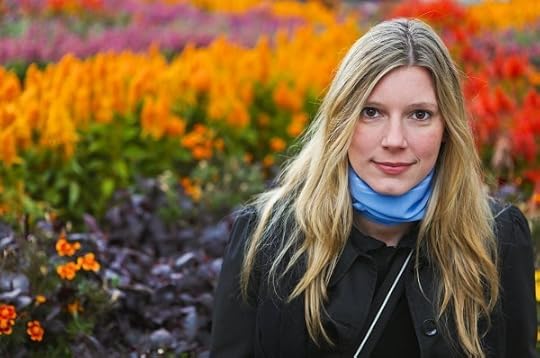
Photo: Rodrigo David
1. When you visit another town, you walk into old, abandoned houses because you assume there is a bar inside.
2. You’ve completely accepted that getting a pizza delivered can take two hours.
3. You understand that “between 5pm and 6pm” means “sometime around 7pm.”
4. You put tejföl (sour cream) on everything. Pizza, pasta, salad. Everything.
5. You now consider Lake Balaton an ocean.
6. You stop wondering why things cost 299HUF when the smallest available coin is 5 Forint. You just accept your loss.
7. You’ve unwillingly appeared as an extra in at least three major Hollywood movies when you’ve walked home late at night, a little bit tipsy. And more than once, you’ve encountered a dead horse in the middle of your street and a carriage full of actors in period dress dressed.
8. The sight of a kürtöskalács home delivery car is totally normal.
9. Every time you have to pay with a 20,000HUF bill, you seriously consider buying something expensive that you don’t actually need just because you are afraid of the cashier’s reaction for having to give you so much change.
10. Even if all three look pretty much the same and are all cooked in the same huge pots over open fire, you know the difference between gulyás, haláslé and pörkolt.
11. Túró Rudi is the only thing that can save you on a long, frustrating day at work.
12. When you go out in the 7th district, you have free wifi covered because so many of the bars serve as your second living room.
13. The day the pizza takeaway (that sells real Italian pizzas and not the usual ketchup and mayo-covered imitations!) opened on Király Street was one of the best days of your life.
14. You can’t imagine shopping at H&M anymore because there are so many amazing secondhand stores to peruse.
15. The existence of the carrot-selling lady at Szimpla Bar is nothing special for you anymore.
16. Speaking of Szimpla, you’ve had to cross it off the list of your favorite bars and call it a crappy tourist hole. Secretly your heart is bleeding, but that’s the only way to get accepted by long-term residents.
17. You can’t remember how you could survive without lángos as midnight snack.
18. Homemade pálinka doesn’t burn like hell anymore. You actually consider the feeling when it’s slowly running down your throat to be quite pleasant and comforting.
19. You have finally succeeded in convincing the 24/7 shop around the corner to sell you alcohol after 10pm.
20. It doesn’t bother you anymore that in most bars you have to keep the toilet door closed with your hands because the lock is broken.
21. A picture of you and your friends is published in an article about “Budapest’s Best Ruin Bars.” You are drinking heavily. Of course.
22. At one point you’ve come to the realization that you and your friends are probably drinking too much. At another point you’ve stopped bothering. It’s Budapest. It’s okay. You are in the best company.
23. You join the crowd standing on public transport although most seats are available. It’s only 10 stops anyway.
24. At least once you’ve bought something in one of the creepy underground shops at Nyugati train station. But you would never admit it to anyone.
25. You frantically start looking for the forralt bor (hot wine) stalls downtown as soon as the temperature drops below 20 degrees.
26. You understand that there is no such thing as “living too long” in Budapest. A part of your heart will always stay here even if one day you leave. And of course you will come back and visit. Because everybody comes back. 

How I became American

Photo: Jonathan Kos-Read
It was my first time in New Orleans. I was in town for an activist conference. It was before Hurricane Katrina. Before Mike Brown was murdered by police in Ferguson, MO. The South was sweet and muggy. Time felt slower.
I wandered, along Tremé, Downtown, the French quarter, almost twisting my foot on the broken sidewalks that seemed like alleys. There were large white buildings that took up entire blocks, Victorian moldings, and high ceilings, their balconies beckoning. I saw a sign for plantation tours visible in a tourist brochure I picked up. My stomach dropped.
I took the bus to meet some new friends for food. Once I stepped on, I could feel eyes like pins on my back. I turned. My chubby body felt like white marble under unflinching stares.
After I got off the bus, someone called to me. “Where are you from?” I mumbled my response, and the voice became louder:
“Where are you REALLY from. No, where are you really from.”
Child of a Chinese immigrant, and a Bronx-born Jew, I got it. I was unintelligible, outside the realm of what people knew.
I met my new friends at Krystal for a burger. There was a swelling line around the corner. “I’m a white boy, you need to serve me first!” came from the lone lanky white man with dirty blond hair.
The line was full of black and brown people. It was hot. Suffocating. My new friend picked up a soda, and threw it at the white man. He stopped harassing the workers, turned all attention to us.
“Go back to where you came from…you…you…you…wontons!”
He didn’t even know the right racial epitaphs for us.
The American South. So full of history — and contradictions. New Orleans still held the legacy of slavery and present-day racial antagonism; I was both invisible, and yet hyper visible.
I softly apologized for whatever transgression I did. It was the first time anyone had declared me American.
The sweet welcome of my host (a friend of friends) softened my image of this antebellum port city, but did not completely undo the backward reactions experienced earlier in the day.
I flashed back, five years before. London. It was my first international trip. I stayed at a youth hostel. London was gray. And diasporic. There were actually plenty of people who looked like me. I noticed people from all over Asia, Africa, and the Caribbean. No eyes fell upon me.
I could be from here, I mused to myself.
The youth hostel looked like a charming French building, with Victorian moldings. It was white and took up a whole city block. It could have been a private Catholic school, or a nunnery, depending on the century. I went down to eat breakfast — English tea and coffee, crumpets, and eggs.
After finding out how to take the train (“Mind the gap” blared repeatedly in my mind when I got lost in the English tunnel), I found the shopping center I was looking for.
My sister and I wandered around. Silver glittery running shoes jumped out at me. Knee socks shimmered in neon metallic. Leopard print scarves waved at me.
I asked the shopkeeper a question; I don’t remember what I said.
“You girls are American,” was her response. Her mouth tightened. “You girls are so American,” she said again. “You want it, and you want it now.”
I softly apologized for whatever transgression I did. It was the first time anyone had declared me American. I glanced around, to see if anyone heard her. No one looked me in the eye. I caught a glimpse of a McDonalds across the street, and a Spice Girls billboard with Baby and Scary and Posh staring down. They held my gaze. I lowered my eyes, saw the newspaper rack. “After 9/11…Shock and awe,” the headline said. I pondered my place in all of this.
I became American in that moment, by offending the British shopkeeper. It was a history I didn’t want to claim. 

October 23, 2014
Harvesting marble is a work of art
From your kitchen countertop to the Siena Cathedral in Italy, marble is associated with beauty and luxury. We all know what it looks like and how much it costs, but one question we never ask ourselves is: how is marble harvested? To my surprise, I discovered that it did not come out of the ground in smooth long slabs rounded around the edges. It requires big heavy excavators and the guidance of the quarry boss, whose behaviour is strangely similar to the one of a music conductor.
“Il Capo” (The Chief) is a movie that follows the work of the man who guides the heavy machines used to extract the famous stone from the ground. Watch the video and you’ll never look at your bathroom floor, or the Taj Mahal, in the same way. 

Matador Network's Blog
- Matador Network's profile
- 6 followers





